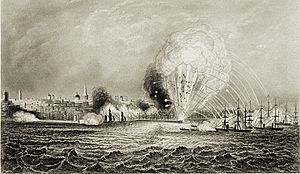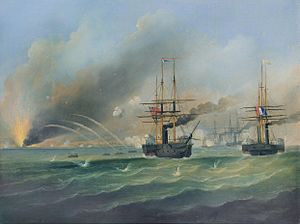1854 bombardment of Odessa facts for kids
Quick facts for kids Bombardment of Odessa |
|||||||
|---|---|---|---|---|---|---|---|
| Part of the Crimean War | |||||||
 Bombardment of Odessa, showing the explosion of the Imperial Mole |
|||||||
|
|||||||
| Belligerents | |||||||
| Commanders and leaders | |||||||
| Strength | |||||||
| Shore batteries and troops |
|
||||||
| Casualties and losses | |||||||
| 5 killed, 15 wounded | |||||||
The Bombardment of Odessa was a major attack during the Crimean War. In this event, a combined group of warships from Britain and France attacked the Russian port city of Odessa. This happened because of a disagreement that quickly grew into a full-scale battle.
Why the Attack Happened
On April 6, 1854, Britain and France had just declared war on Russia. A British ship, Furious, sailed to Odessa. Its captain, William Loring, sent a small boat into the port. This boat was flying a flag of truce, which is a special flag that means "we come in peace." The goal was to pick up the British Consul, who was a government official.
However, as the boat was leaving the port, Russian forces fired at it. The British naval leader, Vice-Admiral James Dundas, was very upset. He asked the Russian military governor of Odessa, Dmitri Osten-Sacken, to explain why they had broken the rules of war. The Russian explanation was not accepted. Because of this, a group of warships was quickly put together to launch a punishment attack.
The attacking group of ships included eight large steam frigates. These were the French ships Descartes, Mogador, and Vauban. The British ships were Furious, Retribution, Sampson, Terrible, and Tiger. They also had support from other ships like the British Highflyer, Arethusa, and Sans Pareil, plus the French Caton. Six smaller boats, armed with powerful rockets, also joined the attack.
The Attack on Odessa
On April 22, the British and French ships arrived near Odessa. They waited offshore. At 5 a.m., the first group of ships, including Descartes, Sampson, Tiger, and Vauban, sailed closer. They began firing at the Russian positions from about 2,000 yards away. At first, their shots did not do much damage.
During the fight, the Vauban was hit by a red-hot cannonball. This hot shot started a fire on board, forcing the ship to move away for a short time. But it soon returned, bringing the ship Caton with it. The second group of ships, including Furious, Terrible, Retribution, and Mogador, then joined the attack. Other ships like Arethusa stayed further back as a backup.
The attacking ships then moved even closer to the port. Soon, a shot from the Terrible hit a magazine (a place where explosives are stored) on the Imperial Mole. The Imperial Mole was a large pier or breakwater in the harbor. The magazine exploded, causing huge damage. About 24 Russian ships in the military port caught fire. Several British and French merchant ships that had been stuck in the port used this confusion to escape.
Meanwhile, the rocket-boats set fire to the dockyard storehouses, where supplies were kept. Later in the battle, the Arethusa attacked some gun positions on the south side of the Quarantine Mole, another part of the port. However, it was called back. Many fires were now threatening the city itself. So, the attack ended at 5:30 p.m., and the ships pulled back.
Very few people were hurt on the British and French side. Two sailors were killed and one was wounded on the Vauban. Three were wounded on the Retribution, six on the Sampson, and one was killed and four wounded on the Terrible.
What Changed After the Attack
This attack, sometimes called an "affair of honor," had a big impact. Odessa was made useless as a naval base for the rest of the war. This meant that the British and French ships could move freely in the Black Sea. This was very important for them to keep their supply lines open after they invaded the Crimean Peninsula in September.
Images for kids




